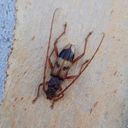Eucalyptus Borer
Phoracantha
Classification
- Phylum: Arthropoda
- Subphylum: Hexapoda
- Class: Insecta
- Order: Coleoptera
- Suborder: Polyphaga
- Superfamily: Chrysomeloidea
- Family: Cerambycidae
- Subfamily: Cerambycinae
- Tribe: Phoracanthini
- Genus: Phoracantha
Pronunciation
How to pronounce Phoracantha: //ˌfɔrəˈkænθə//
These audio files are automatically generated. While they are not always 100% accurate, they are a good starting point.
Images






Summary
Phoracantha semipunctata, or the Australian Eucalyptus longhorn, is an invasive beetle species affecting Eucalyptus trees worldwide, particularly in stressed conditions.
Physical Characteristics
Typically dark brown & beige in colour, measuring around 2.3 cm long, with a protruding spine at the end.
Identification Tips
Similar to P. recurva, but differs in larger size and more extensive dark markings.
Habitat
Primarily found within Eucalyptus trees, especially stressed ones, and decaying branches.
Distribution
Native to Australia; adventive in North America and other Eucalyptus-growing regions worldwide; first detected in North America in 1984.
Diet
Primarily feeds on pollen and nectar within host trees.
Life Cycle
Four stages: Egg, larval, pupation, and adult.
Reproduction
Females lay approximately 40 eggs below detached bark in stressed host trees; larvae feed on cambium and phloem tissues of the tree.
Predators
Natural predators include braconid parasitoids like Syngaster lepidus and Bracon capitator, and beetles like Trogodendron fasciculatum.
Ecosystem Role
Considered an invasive pest species of Eucalyptus outside Australia; plays a role in the ecological dynamics of its introduced ranges.
Economic Impact
Not regarded as a major pest in its native Australia; becomes a significant pest problem in non-native ecosystems, particularly in regions with stressed Eucalyptus trees.
Evolution
Part of the Cerambycinae subfamily, shares ecological traits with other longhorned beetles.
Similar Taxa
- P. recurva
- Coptocercus
- Allotisis
- Thoris
- Epithora
- Skeletodes
- Atesta
- Paratesta
- Steata
- Coleocoptus
- Phytrocaria
- Semiphoracantha
Tags
- Eucalyptus
- invasive species
- Coleoptera
- Cerambycidae
- longhorn beetle